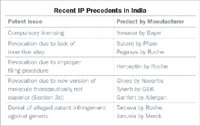"Market-Based" Price Controls In India?
Three strategic implications for pharma pricing strategies in India.
India's Department of Pharmaceuticals (DoP) released the Drug Price Control Order (DPCO) in May 2013. It increased the number of drugs on the National List of Essential Medicines (NLEM) from 74 to 348 and offers new paradigms for determining and enforcing price ceilings while maintaining stable drug supply. Biopharmaceutical companies that do business in India need to carefully evaluate the consequences of this legislation.
The DPCO has three primary aims: expanding the NLEM, authorizing the National Pharmaceutical Pricing Authority (NPPA) to regulate prices of India's NLEM, and authorizing the NPPA to regulate price increases of non-essential medicines. The DPCO uses market-based mechanisms to set price ceilings. It works differently, depending on how many products are in a category:
» If a drug is one of many drugs within a given product category, the price ceiling is the simple average of the prices of all drugs that have at least 1% of market share within that category (plus a 16% pharmacists' margin).
» If a drug is the only one within a given drug category, the new price ceiling for that category will be a fixed percent, based on price reductions in similar categories.
Moving forward, all drugs in a product category must be priced at or below the price ceiling or the manufacturer will face monetary penalties. If a drug's price is already below the price ceiling, a price increase is prohibited. The NPPA, however, currently has no mechanism to officially penalize an offending manufacturer. For all NLEM-listed treatments, yearly price increases must be in line with or below the wholesale price index.
The Indian government has also reserved the right to mandate continued production for up to 12 months, to require quarterly drug production reports, and to require six months' notice before production of a given drug ceases. The regulation also exempts all drugs developed and patented in India from price control as a means of incentivizing India-based research and development.
The DPCO results in three key implications for pharmaceutical and biotechnology companies in India, as well as for the country as a place for future clinical R&D:
» Fewer "branded generics."
» No let-up in pricing pressure for non-NLEM drugs.
» No dramatic change in MNC R&D investment in India.
Fewer "branded generics"
To understand how this new policy will impact prices within the Indian market, consider the following three cases:
» Because Novartis' desferrioxamine mesylate is the only drug within its product category, it experiences price reduction as a fixed percentage of its current price. In order to determine the price reduction for desferrioxamine mesylate, the NPAA considers the average reduction in similar product categories. For desferrioxamine mesylate, the price reduction will be 24.80%, the average price reduction for antidotes. This will reduce the price per unit from its current R170.40 to R128.14.
» GlaxoSmithKline's hepatitis B vaccine is significantly more expensive than the other seven options. Because the new price ceiling is determined by an arithmetic, and not a weighted average, the price ceiling for hepatitis B vaccines will force the price of GSK's vaccine significantly down from over R300 to a maximum of R87, a roughly 75% reduction.
» A local manufacturer (Pavior Pharmaceuticals) offers a more expensive factor VIII concentrate injection than the only alternative, Baxter's cheaper version. According to clearly outlined DPCO policy, the new price ceiling for factor VIII concentrates will become the average of current prices, or about R5400. Baxter's factor VIII is priced well below where the new price ceiling would be, so Baxter will not face mandatory price reduction. This is a particularly interesting case, as the DPCO aims to impact high-priced branded options that compete against a set of generic and "branded generic" alternatives. Baxter's product has over 90% of market share, so the price ceiling will not have any impact on the category spend.
In order to understand the reach of the DPCO's price reduction policies, one must fully understand the India market. Consumers and physicians in the country are very brand-conscious, even when it comes to medications. As a result, higher drug prices don't necessarily lead to lower market share. Indeed, for almost half of the product categories under the DPCO (47%), the most commonly used drug is also the most expensive. Consider the hepatitis B vaccine market from case No. 2. GSK's product, despite being the most expensive by a wide margin, has a disproportionate 26% market share. This is because market share and price are not inversely related in this product category as would typically be expected. Thus, this category demonstrates DPCO's potential success. Though GSK's drug is the only therapy that will face significant price reduction due to its high market share, the weighted average of prices in this category will be slashed in half from R140 to R70.
As a result of the DPCO, price differentiation for NLEM-listed medications will become increasingly difficult. More importantly, the DPCO may impact locally-manufactured generic alternatives as it reduces the price of the MNC branded options, thus decreasing the price gap and perhaps making the MNC brand more attractive. As price differentiation within each product category decreases, so too does the potential for a middle tier, products that are neither the most nor the least expensive in the category of "branded generics." This will lead to a decrease in the overall number of "branded generic" NLEM products across all categories.
No let-up in pricing pressure for non-NLEM drugs
An estimated 70% of the India drug market is not listed on the NLEM and will not face new price ceilings or mandatory price reductions. However, medicines not listed on the NLEM will only be permitted a 10% annual price increase. In addition, pricing opportunities remain limited by patient affordability and the threat of compulsory licensing. The Indian government has a history of implementing compulsory licensing and revoking patents for drugs it considers too expensive. Nine drugs for either cancer or diabetes have faced patent problems ranging from compulsory licensing to revocation of patents to denial of patent infringement in India (see chart). These patent problems have led to cheaper generic alternatives for high-cost medicines in India, and have also positioned India as a country in which exceptionally high-priced therapies are unlikely to launch successfully.

Recent IP Precedents in India
MNC R&D investment in India will not change dramatically
The DPCO incentivizes India-based research and development of drugs. However, the likelihood that this will influence investment decisions by MNCs is negligible. MNCs often have established R&D centers outside of India. Since revenue from NLEM drugs for MNCs in the context of their global revenues is very small, it is very unlikely that many of these companies will make a large R&D investment in India because of the DPCO.
Next steps
The Indian government is heavily involved in regulating prices for medicines in India by using the DPCO to set price maximums for essential medicines. Going forward, the Indian government may also look to other larger areas of the pharmaceutical/biotech market to introduce new and increased regulation to make medicines more affordable. To be successful in a changing India market, manufacturers need to constantly review the changing policy landscape and reassess their India strategy carefully.

Ram Subramanian is a Director, he can be reached at ram.subramanian@simon-kucher.com; Nikhil Mutyal is a Consultant, he can be reached at nikhil.mutyal@simon-kucher.com; Emma Nechamkin is a Consultant, she can be reached at emma.nechamkin@simon-kucher.com; all at Simon-Kucher & Partners
FDA Grants Priority Review to Regeneron’s Eylea for Macular Edema Following Retinal Vein Occlusion
April 18th 2025Regulatory action was based on data from the Phase III QUASAR trial, which demonstrated that Eylea HD dosed every eight weeks achieved non-inferior visual acuity outcomes compared to Eylea in patients with macular edema following retinal vein occlusion.
Navigating Distrust: Pharma in the Age of Social Media
February 18th 2025Ian Baer, Founder and CEO of Sooth, discusses how the growing distrust in social media will impact industry marketing strategies and the relationships between pharmaceutical companies and the patients they aim to serve. He also explains dark social, how to combat misinformation, closing the trust gap, and more.
